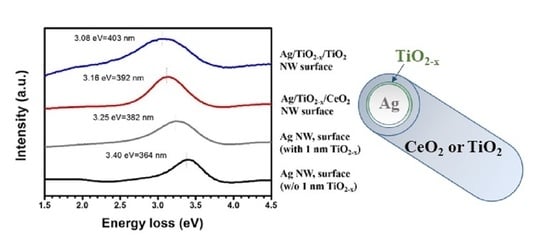Template-Free and Surfactant-Free Synthesis of Selective Multi-Oxide-Coated Ag Nanowires Enabling Tunable Surface Plasmon Resonance
Abstract
:1. Introduction
2. Experimental Procedures
3. Results and Discussion
4. Conclusions
Author Contributions
Funding
Acknowledgments
Conflicts of Interest
References
- Sun, M.; Fu, W.; Yang, H.; Sui, Y.; Zhao, B.; Yin, G.; Li, Q.; Zhao, H.; Zou, G. One-step synthesis of coaxial Ag/TiO2 nanowire arrays on transparent conducting substrates: Enhanced electron collection in dye-sensitized solar cells. Electrochem. Commun. 2011, 13, 1324–1327. [Google Scholar] [CrossRef]
- Sahu, G.; Gordon, S.W.; Tarr, M.A. Synthesis and application of core-shell Au–TiO2nanowire photoanode materials for dye sensitized solar cells. RSC Adv. 2012, 2, 573–582. [Google Scholar] [CrossRef]
- Sahu, G.; Wang, K.; Gordon, S.W.; Zhou, W.; Tarr, M.A. Core-shell Au–TiO2 nanoarchitectures formed by pulsed laser deposition for enhanced efficiency in dye sensitized solar cells. RSC Adv. 2012, 2, 3791–3800. [Google Scholar] [CrossRef]
- Wang, Y.F.; Zeng, J.H.; Li, Y. Silver/titania nanocable as fast electron transport channel for dye-sensitized solar cells. Electrochim. Acta 2013, 87, 256–260. [Google Scholar] [CrossRef]
- Zhang, J.; Li, L.; Huang, X. Fabrication of Ag–CeO2 core–shell nanospheres with enhanced catalytic performance due to strengthening of the interfacial interactions. J. Mater. Chem. 2012, 22, 10480. [Google Scholar] [CrossRef]
- Dong, Q.; Yu, H.; Jiao, Z.; Lu, G.; Bi, Y. New facile synthesis of one-dimensional Ag@TiO2 anatase core–shell nanowires for enhanced photocatalytic properties. RSC Adv. 2014, 4, 59114–59117. [Google Scholar] [CrossRef]
- Eom, H.; Jung, J.-Y.; Shin, Y.; Kim, S.; Choi, J.-H.; Lee, E.; Jeong, J.-H.; Park, I. Strong localized surface plasmon resonance effects of Ag/TiO2core–shell nanowire arrays in UV and visible light for photocatalytic activity. Nanoscale 2014, 6, 226–234. [Google Scholar] [CrossRef] [PubMed]
- Galicia, G.M.; Hernández, R.P.; Wing, C.E.G.; Anaya, D.M. A novel synthesis method to produce silver-doped CeO2nanotubes based on Ag nanowire templates. Phys. Chem. Chem. Phys. 2011, 13, 16756. [Google Scholar] [CrossRef] [PubMed]
- Hajimammadov, R.; Bykov, A.; Popov, A.; Juhász, K.L.; Lorite, G.S.; Mohl, M.; Kukovecz, A.; Huuhtanen, M.; Kordas, K. Random networks of core-shell-like Cu-Cu2O/CuO nanowires as surface plasmon resonance-enhanced sensors. Sci. Rep. 2018, 8, 4708. [Google Scholar] [CrossRef] [PubMed] [Green Version]
- Loua, Y.; Zhang, Y.; Cheng, L.; Chena, J.; Zhao, Y. A Stable Plasmonic Cu@Cu2O/ZnO Heterojunction for Enhanced Photocatalytic Hydrogen Generation. ChemSusChem 2018, 11, 1505–1511. [Google Scholar] [CrossRef] [PubMed]
- Tsai, C.-H.; Chen, S.-Y.; Song, J.-M.; Gloter, A. Spontaneous growth of ultra-thin titanium oxides shell on Ag nanowires: An electron energy loss spectroscope observation. Chem. Commun. 2015, 51, 16825–16828. [Google Scholar] [CrossRef] [PubMed]
- Tung, H.-T.; Chen, I.-G.; Song, J.-M.; Yen, C.-W. Thermally assisted photoreduction of vertical silver nanowires. J. Mater. Chem. 2009, 19, 2386. [Google Scholar] [CrossRef]
- Song, J.-M.; Chen, S.-Y.; Shen, Y.-L.; Tsai, C.-H.; Feng, S.-W.; Tung, H.-T.; Chen, I.-G. Effect of surface physics of metal oxides on the ability to form metallic nanowires. Appl. Surf. Sci. 2013, 285, 450–457. [Google Scholar] [CrossRef]
- Tsai, C.H.; Chen, S.Y.; Song, J.M.; Gloter, A. Spectroscopic study on spontaneously grownsilver@ultra-thin cerium oxide nanostructures. RSC Adv. 2016, 6, 114425–114429. [Google Scholar] [CrossRef]
- Rossouw, D.; Couillard, M.; Vickery, J.; Kumacheva, E.; Botton, G. Multipolar Plasmonic Resonances in Silver Nanowire Antennas Imaged with a Subnanometer Electron Probe. Nano Lett. 2011, 11, 1499–1504. [Google Scholar] [CrossRef] [PubMed]
- Scholl, J.A.; Koh, A.L.; Dionne, J.A. Quantum plasmon resonances of individual metallic nanoparticles. Nature 2012, 483, 421–427. [Google Scholar] [CrossRef] [PubMed]
- Hirakawa, T.; Kamat, P.V. Charge Separation and Catalytic Activity of Ag@TiO2 Core−Shell Composite Clusters under UV−Irradiation. J. Am. Chem. Soc. 2005, 127, 3928–3934. [Google Scholar] [CrossRef] [PubMed]
- Singh, R.; Soni, R.K. Synthesis of rattle-type Ag@Al2O3 nanostructure by laser-induced heating of Ag and Al nanoparticles. Appl. Phys. A 2015, 121, 261–271. [Google Scholar] [CrossRef]
- Faure, B.; Salazar-Alvarez, G.; Ahniyaz, A.; Villaluenga, I.; Berriozabal, G.; De Miguel, Y.R.; Bergström, L. Dispersion and surface functionalization of oxide nanoparticles for transparent photocatalytic and UV-protecting coatings and sunscreens. Sci. Technol. Adv. Mater. 2013, 14, 23001. [Google Scholar] [CrossRef] [PubMed]







© 2020 by the authors. Licensee MDPI, Basel, Switzerland. This article is an open access article distributed under the terms and conditions of the Creative Commons Attribution (CC BY) license (http://creativecommons.org/licenses/by/4.0/).
Share and Cite
Tsai, C.-H.; Chen, S.-Y.; Gloter, A.; Song, J.-M. Template-Free and Surfactant-Free Synthesis of Selective Multi-Oxide-Coated Ag Nanowires Enabling Tunable Surface Plasmon Resonance. Nanomaterials 2020, 10, 1949. https://doi.org/10.3390/nano10101949
Tsai C-H, Chen S-Y, Gloter A, Song J-M. Template-Free and Surfactant-Free Synthesis of Selective Multi-Oxide-Coated Ag Nanowires Enabling Tunable Surface Plasmon Resonance. Nanomaterials. 2020; 10(10):1949. https://doi.org/10.3390/nano10101949
Chicago/Turabian StyleTsai, Chi-Hang, Shih-Yun Chen, Alexandre Gloter, and Jenn-Ming Song. 2020. "Template-Free and Surfactant-Free Synthesis of Selective Multi-Oxide-Coated Ag Nanowires Enabling Tunable Surface Plasmon Resonance" Nanomaterials 10, no. 10: 1949. https://doi.org/10.3390/nano10101949




